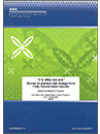This report summarises the findings from case studies of seven schools that are part of the Positive Behaviour for Learning School-Wide (PB4L-SW) initiative. Schools were selected for their effective practice. In this report, commonalities and differences in practice are summarised, and key themes are illustrated by short narratives from the schools. The report also discusses the contribution PB4L-SW is making towards change at the schools. The main audiences for this report are schools and Ministry of Education staff who provide support and training to schools.
Key Results
What does effective practice in PB4L-SW schools look like in a New Zealand context?
At the case study schools, staff and students were strongly supportive of PB4L-SW mainly because the initiative had assisted them to build a stronger and more positive school community. For the case study schools, effective implementation of PB4L-SW rested on these interconnected features.
Deliberate leadership. Generally, schools had:
- leaders who had a moral purpose and a long-term vision about supporting the academic and social learning of students
- leaders who were skilled change managers and who committed ongoing resources to PB4L-SWa
- PB4L-SW team with a mix of the "right people" who could work collaboratively to build approaches and find creative solutions to issues
- embedded the use of PB4L-SW data within problem-solving and decision-making processes.
An ongoing commitment to staff and school learning relating to PB4L-SW. Generally, schools had:
- a commitment to taking all staff on the PB4L-SW journey
- processes for working at the pace of staff to build practice and consistency
- a planned process of in-house and external professional learning and development (PLD) which built staff capabilities over time
- a commitment to building new school leaders through the PB4L-SW team
- processes for working with staff who found it harder to adjust to PB4L-SW
- relationships with external people who provided support or acted as a critical frienda
- commitment to sharing practice through local PB4L-SW school clusters.
Clear processes for teaching expectations and acknowledging behaviours. Generally, schools had:
- time set aside and clear processes for teaching and acknowledging behaviour expectations
- multi-layered approaches to teaching expectations that included just-in-time approaches based on current data and longer-term processes that were embedded in the curriculum
- resources that were collaboratively developed to support the teaching of expectations
- multi-layered award systems that aimed to address different settings and student needs
- systems for collecting data about awards to strategically target students who might miss out
- consistent and well-known systems for addressing behaviour incidents, and training for staff
- ways of working that were effective for diverse groups of students including Māori, Pasifika, and students with special education needs.
Ways of bringing students, parents, and whānau communities onboard. Generally, schools had:
- processes for building student leaders and ownership over PB4L-SW through seeking feedback
- a commitment to sharing students' successes and school approaches with parents and whānau
- processes that built early and positive relationships with vulnerable students and their whānau
- built relationships with Māori or Pasifika community leaders who could support the school to consult with whānau and families, and inform the direction of the school.
A few schools had:
- woven PB4L-SW and te ao Māori together to realise their commitment to supporting the success of Māori students
- developed a wider web of PB4L-SW practice through reaching out to share their approaches with local education providers or community groups.
A commitment to long-term sustainability: Generally, schools had:
- processes for "keeping PB4L-SW fresh" through PLD and ongoing improvement processes
- ongoing PLD relating to PB4L-SW for all staff and processes for training new staff and relievers
- interwoven PB4L-SW practice or philosophies within other school practices to enhance these practices and ensure that PB4L-SW became part of the fabric of the school.
What outcomes or changes were schools seeing in connection to PB4L-SW?
Most of the expected medium-term outcomes associated with PB4L-SW were evident at these schools. Staff considered PB4L-SW was a key contributing factor to these changes. Some of the main shifts included:
a safer, more respectful and inclusive school culture and a stronger sense of community.
For students
- fewer major behaviour incidents including suspensions and exclusions
- improved ability to relate well to others, and model school values
- a sense of pride and belonging to their school.
For teachers
- a shift in teacher practice towards a more positive mindset and approaches to behaviour
- less time spent managing behaviour incidents
- increased job satisfaction.
For school leadership, culture, and systems
- a clearer "brand" and shared sense of purpose and values that drove the school
- a stronger collegial and team-based problem-solving culture
- shared systems and more consistency in teaching and acknowledging positive behaviour and in addressing behaviour incidents
- a coherent PLD system and opportunities to build expertise and practice.
What hindered change or challenged schools?
- Building shared beliefs and practices across all staff and maintaining consistency over time
- Sourcing integrated data systems to manage data
- Developing consequence systems that supported learning
- Finding a way to balance a focus on extrinsic and intrinsic acknowledgements of behaviour
- Finding ways to support the small number of students for whom PB4L-SW tier 1 did not "work"
- Forming stronger links with parents and whānau particularly Māori and Pasifika communities.
Where to next for schools and the wider education system?
- Building stronger connections to Māori and Pasifika worldviews, families, and communities
- Finding ways to support schools to manage data
- Finding joined-up ways to work with other agencies to support vulnerable students.

